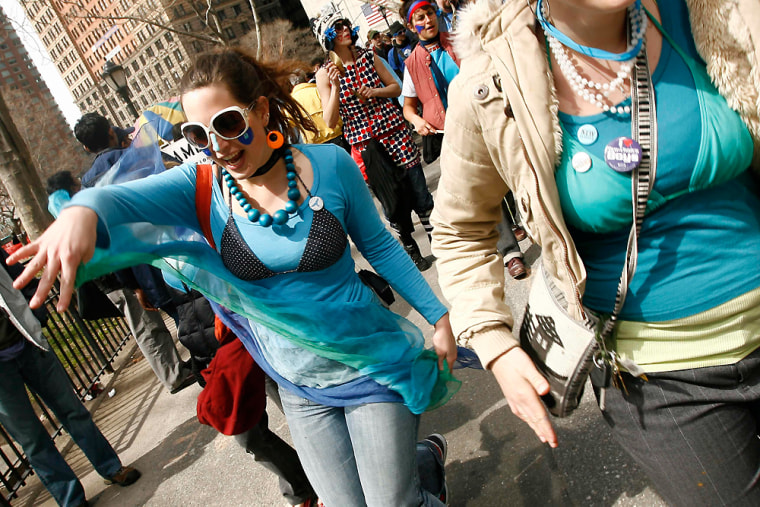Americans worried about climate change gathered Saturday on ski slopes and in cities for a nationwide day of demonstrations aimed at drawing attention to global warming.
More than 1,300 events were organized in every state under the banner Step It Up 2007 to push Congress to require an 80 percent cut in carbon dioxide emissions by 2050.
“When it comes to global warming, I don’t exactly think President Bush is doing such a hot job,” said 12-year-old New Yorker Tiffany Cordero. “A lot of people are thinking just of now. But we won’t have a ’now’ if we don’t focus on the future.”
Tiffany delivered a speech for a rally in lower Manhattan’s Battery Park, overlooking New York Harbor, where people dressed in blue — some equipped with scuba gear and beach balls — gathered to form a Sea of People human line to symbolically mark New York’s future coastline.
Scientists say melting polar ice caps and glaciers will cause ocean levels to rise, although estimates vary. The Intergovernmental Panel on Climate Change has projected that ocean levels will rise 7 to 23 inches this century, but other scientists warn the sea level could rise 10 feet or more, enough to flood Lower Manhattan other low-lying coastal areas.
The threatened rise in the ocean also was dramatized by a New Coast Parade in Portland, Maine, one of more than 30 observances in that state. “The most important things that we have a responsibility to do in government are to prepare our children for a bright future and to preserve and protect our natural resources,” Maine Gov. John Baldacci told a gathering in Portland.
Effort began with students
The nationwide events were spearheaded by a group of recent graduates from Vermont’s Middlebury College, who organized a campaign of blogs, e-mail messages and word of mouth communications.
“We see this to be the most pressing issue of our time, and our generation,” said Will Bates, 23, one of six former Middlebury students who helped organize the event with author Bill McKibben, a scholar in residence at the college and among the first to write about global warming, in his 1989 book “The End of Nature.”
In Chicago’s Daley Plaza, about 500 people listened to speeches from a panel of environmental experts who called for a reduction in carbon dioxide emissions. The crowd also waved signs exclaiming “Step it up Congress.”
In Santa Monica, hundreds gathered along the Third Street Promenade just east of the Pacific Ocean to listen to lectures and listen to makers of “green” products pitch their wares.
“We have such a wonderful planet and it is really tragic for us to ruin it with global warming,” said organizer Jim Stewart of Earth Day L.A. “The bottom line is everybody needs to be carbon-neutral.”
In one of the day’s first demonstrations, skiers unfurled a protest banner in April snow on Whiteface Mountain near Wilmington, N.Y. Another group made an early morning hike to the summit of Maine’s Cadillac Mountain, which is the first spot in the U.S. to be lit by the rising sun.
Signs big and small
The Whiteface Mountain skiers fear long-term temperature increases promise trouble for native plants, wildlife and people in the Adirondack Mountains of northern New York state.
“It’s subtle,” said Nola Royce, who has been going to the Adirondacks since 1971. For example, she said, the region’s notorious, biting black flies are emerging earlier in the season.
Neil Woodworth, executive director of the Adirondack Mountain Club, said less obvious concerns about warming include pests moving northward. He mentioned tick-borne Lyme disease, now a problem farther south in Connecticut, New Jersey and southern New York, as well as the Sirex wood wasp, hemlock woolly adelgid and Asian longhorned beetle.
“All these tree eaters normally prefer more temperate climates than the Adirondacks,” Woodworth said. “And as the Adirondack climate gets warmer in the winters the below-freezing barrier that has held these pests at bay is going to be lost.”
The campaign is online at www.stepitup2007.org/.
